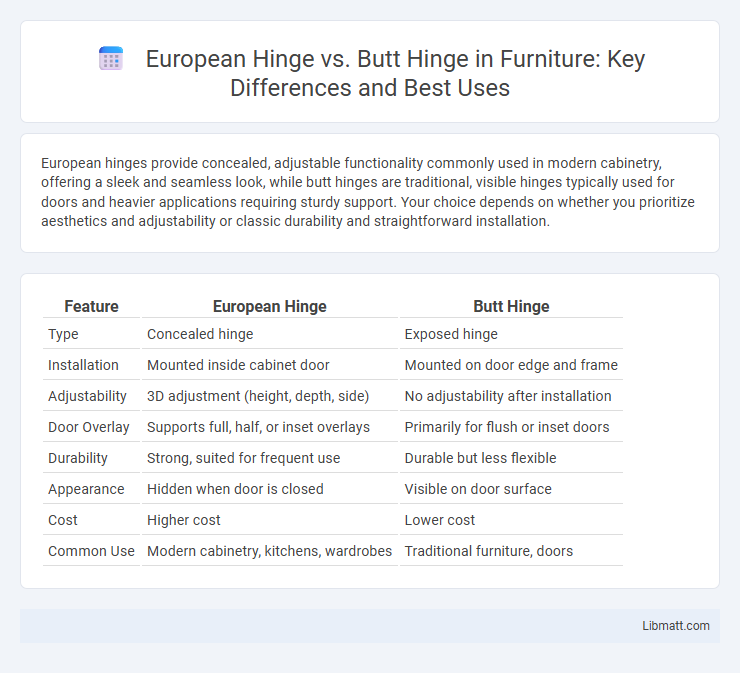European hinges provide concealed, adjustable functionality commonly used in modern cabinetry, offering a sleek and seamless look, while butt hinges are traditional, visible hinges typically used for doors and heavier applications requiring sturdy support. Your choice depends on whether you prioritize aesthetics and adjustability or classic durability and straightforward installation.
Table of Comparison
| Feature | European Hinge | Butt Hinge |
|---|---|---|
| Type | Concealed hinge | Exposed hinge |
| Installation | Mounted inside cabinet door | Mounted on door edge and frame |
| Adjustability | 3D adjustment (height, depth, side) | No adjustability after installation |
| Door Overlay | Supports full, half, or inset overlays | Primarily for flush or inset doors |
| Durability | Strong, suited for frequent use | Durable but less flexible |
| Appearance | Hidden when door is closed | Visible on door surface |
| Cost | Higher cost | Lower cost |
| Common Use | Modern cabinetry, kitchens, wardrobes | Traditional furniture, doors |
Introduction to Cabinet Hinges
European hinges offer concealed installation and adjustable features for sleek, modern cabinetry, enhancing your furniture's aesthetics and functionality. Butt hinges, traditional and visible, provide sturdy support ideal for heavy cabinet doors but lack adjustability. Choosing between these hinges affects cabinet appearance, ease of installation, and maintenance, making it essential to consider your design needs.
Overview of European Hinges
European hinges, also known as concealed or cup hinges, offer a sleek design ideal for frameless cabinetry, providing full adjustability and easy installation without visible hardware. They typically feature a cup diameter of 35mm and allow for soft-closing mechanisms, enhancing cabinet durability and user experience. Your furniture benefits from precise alignment and a modern aesthetic when utilizing these hinges compared to traditional butt hinges, which are surface-mounted and less adjustable.
What Are Butt Hinges?
Butt hinges are traditional hinges consisting of two plates joined by a central pin, commonly used on doors and cabinets in both residential and commercial settings. Unlike European hinges, which are concealed and offer adjustable features, butt hinges are visible and provide straightforward installation with durable pivoting support. Your choice between these hinges depends on whether you prioritize aesthetics and adjustability or classic design and simplicity.
Design and Structure Comparison
European hinges feature a concealed cup design that mounts inside a recessed hole on the door, offering a sleek appearance and allowing for easy adjustability in three directions. Butt hinges consist of two rectangular plates joined by a pin, surface-mounted on the edge of the door and frame, resulting in a visible, traditional look with limited adjustment capabilities. The European hinge supports full overlay doors with soft-close mechanisms, while butt hinges are better suited for inset doors without integrated soft-closing features.
Installation Process: European vs Butt Hinges
European hinges feature a concealed mounting system that requires precise drilling holes, typically 35mm in diameter, allowing for adjustable alignment and a flush cabinet door fit. Butt hinges demand straightforward surface mounting with screws drilled directly into the door and frame, often necessitating mortising to ensure proper door flushness. The installation of European hinges offers greater flexibility and a cleaner aesthetic, while butt hinges are simpler but may require more carpentry skill for perfect alignment.
Aesthetic Differences
European hinges offer a sleek, concealed design that enhances cabinetry aesthetics by maintaining clean, uninterrupted surfaces, ideal for modern and minimalist interiors. Butt hinges are visible when doors are closed, providing a more traditional or rustic look that can complement classic furniture styles. Your choice between these hinges significantly impacts the visual appeal, with European hinges delivering subtle elegance while butt hinges add character and craftsmanship detail.
Durability and Load Capacity
European hinges feature a concealed design with robust steel construction, providing superior durability and handling higher load capacities compared to traditional butt hinges. Butt hinges, often made from brass or stainless steel, offer reliable support but generally support lighter weights and experience more wear over time. The advanced engineering of European hinges allows for smoother operation and better weight distribution, making them ideal for heavy cabinet doors.
Application Suitability
European hinges offer superior application suitability for frameless cabinet doors, allowing for a concealed look and easy adjustability, making them ideal for modern kitchen and furniture designs. Butt hinges are better suited for traditional wooden doors and furniture where visibility and robustness are desired, commonly used in door frames and heavy-duty applications. The choice hinges largely on cabinet style, door material, and the required ease of installation and adjustment.
Cost Considerations
European hinges typically cost more upfront compared to butt hinges due to their complex design and enhanced functionality, such as soft-closing and adjustability features. Butt hinges are generally more affordable and widely available, making them a cost-effective option for budget-conscious projects. Long-term, European hinges may offer better value by reducing maintenance and improving door durability, potentially lowering replacement expenses.
Choosing the Right Hinge for Your Project
European hinges offer concealed installation with adjustable features, making them ideal for modern cabinetry requiring a clean look and precise door alignment. Butt hinges, traditionally exposed and made from metal, provide robust support for heavier doors and are best suited for classic or rustic designs. Evaluating your project's aesthetic and functional needs will help guide your choice between these two hinge types, ensuring Your doors operate smoothly and complement the overall design.
European hinge vs butt hinge Infographic

 libmatt.com
libmatt.com